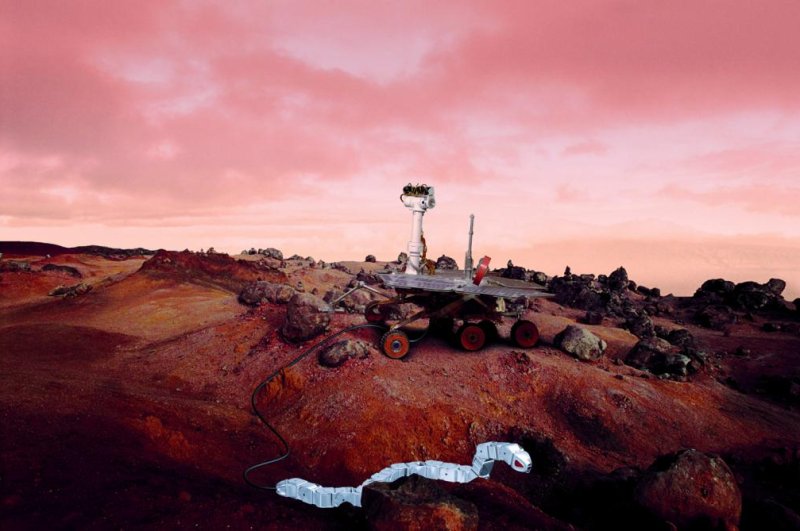An artistic rendering shows the snake robot exploring the Martian surface alongside a rover. Photo by SINTEF
June 21 (UPI) -- Scientists at SINTEF, a research institute in Norway, are working on designs for a snake robot that could one day carry out maintenance missions on the space station and explore lava tubes on the moon.
The research is being funded by the European Space Agency, which is intent on establishing an international settlement on the moon. ESA scientists suggest lava tubes, underground tunnels were lava once flowed, could offer a natural structure to build a settlement in and around.
An autonomous robot capable of exploring underground chambers could be helpful in preparing for such an ambitious project.
ESA also foresees a comet-exploration role for the snake robot. The space agency attempted to put a lander on the surface of the comet 67P/Tsjurjumov-Gerasimenko in 2014. The mission was partially successful, but the Philae lander took a hard bounce off the comet's surface, sending it off course and into a dark valley where communication was difficult and its solar panels couldn't recharge its batteries.
A smaller, slimmer lander design -- like a snake -- could ensure a smoother entry and greater maneuverability on the next comet exploration mission.
"There is pretty much no gravity on a comet. If you try to walk on the surface, you could be thrown into space," Aksel Transeth, SINTEF researcher, said in a news release. "So we have to find ways in which snake robots can move around on a comet while at the same time keeping themselves fixed on the surface."
New moon and comet missions may be several years away, but a snake robot could be used to assist with maintenance on the International Space Station tomorrow. If a robot could assume some of the ISS astronauts' maintenance and repair duties, they could spend more time conducting science experiments.
One of the main challenges facing SINTEF scientists, as they figure out how to build a snake robot, is ensuring the robot can navigate a microgravity environment.
"We believe that we can design a robot that can hold on, roll itself up and then extend its body in order to reach new contact points," said Transeth. "Moreover, we believe that it can creep in among equipment components on the ISS and use equipment surfaces to gain traction in order to keep moving forward -- much in the same way as real snakes do in the wild."
In the next year, NASA is scheduled to send three small robots named Astrobee to the space station. The miniature probe will help astronauts with a variety of tasks. Researchers at SINTEF hope the successes and failures of the project will information their efforts to build a similarly helpful snake robot.















